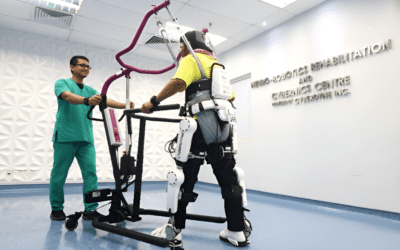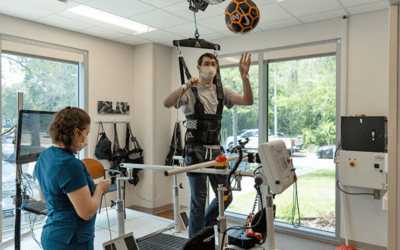Introduction: Why Cancer Rehabilitation is More Important Than Ever
As per the Survey of the National Cancer Institute (NCI), USA, the year 2022 witnessed an alarming estimate of 20 million new cancer cases and 9.7 million cancer-related deaths globally. This data underscores the pressing need for oncology rehabilitation, as it’s projected that by 2040, the annual new cancer cases will surge to 29.9 million, accompanied by a rise in cancer-related deaths.
After cancer, life changes. Oncological rehab helps patients regain autonomy despite sickness and treatments. When it comes to considering rehabilitation for individuals facing significant functional limitations and adverse reactions to chemotherapy or radiotherapy, expertise is required. Their expertise is also crucial in addressing issues like malnutrition or undernutrition, oncology physiotherapy and the lack of specialized care at home, which may necessitate inpatient rehabilitation.
Furthermore, their attention to detail is evident in considering interventions such as artificial feeding, stoma insertion, pain management, and treatment of healing disorders.

What are the goals of Oncology Rehabilitation?
Cancer rehabilitation programs help individuals with cancer maintain and restore their physical and emotional well-being, aiding in a quicker and more comprehensive recovery from cancer treatment.
There are three levels of assessment and planning for cancer rehabilitation.
Step 1: Understanding Your Unique Cancer Rehabilitation Needs
Understand the rehabilitation needs related to cancer and its treatment effects. Establish an evaluation plan and use a decision-making framework to select appropriate rehabilitation interventions for cancer patients.
Step 2: Tailoring Care to Your Specific Cancer Type
A) Recognize and understand the unique rehabilitation needs related to the following:
- Pathology, location, and stage of disease for specific cancers
- Medical treatment interventions related to specific cancers, including surgical reconstruction
- Dysfunction is commonly associated with particular cancers, including breast, prostate, lung, head and neck, andhematologic cancers.
B) Determine evaluation protocols based on the following:
- Stage of disease and prognosis
- Patient goals and residual functional problems
- Outcome measures validated in specific populations
- Clinical observations relating to common side effects of treatments
- Physical examination and functional tests adapted to the location and trajectory of the cancer
C) Determine intervention strategies based on realistic goals and client-centered outcomes that may include, but are not limited to:
- Education
- Manual therapy
- Therapeutic exercise
- Functional testing and activity training

Step 3: Advanced Cancer Care for Complex Cases
- Develop intervention strategies for complex patient populations with significant rehabilitation needs.
- To support patients who have had reconstructive surgery for head and neck or breast cancer, as well as young osteosarcoma patients and palliative care patients with advanced disease.
- Provide education, prescribe exercises, and manage risks for those with advanced cancers, bone metastases, and lymphedema.
- Identify barriers to returning to work and establish rehabilitation programs for cancer patients in public or private clinical settings based on successful care models in the literature.
Who’s on Your Cancer Rehab Team? Meet the Experts
The interdisciplinary approach to oncology rehabilitation involves a team of specialists, including doctors, psychiatrists, psychologists, and specialized nursing staff. This diverse team monitors developments and implements appropriate measures, ensuring comprehensive patient care.
- Various therapies, including movement, occupational, art, music, and nutritional therapy, contribute to overall well-being and facilitate healing.
- The pleasant atmosphere, excellent environment, and restaurant services further contribute to the overall well-being during the rehabilitation period.
- During rehabilitation, interviews and examinations are conducted regularly to assess the individual’s physical and psychological well-being.
How is the Assessment for Cancer Rehabilitation conducted?
- A comprehensive assessment process will be conducted, which includes a range of outcome measures and well-established tools such as the Surveys and the Assessment of Cancer Therapy, which provide valuable insights into your overall well-being and quality of life.
- The assessment will evaluate your independence in activities of daily living and instrumental activities of daily living,ensuring a thorough and constructive evaluation of your progress and overall functioning post-treatment or interventions.
- Additionally, specific assessment tools are utilized to gauge fatigue levels, functional mobility, exercise behavior, andcognitive function through neuropsychological tests, patient-reported outcome measures, communication skills, sexual function, and the patient’s readiness to return to work.
- This holistic approach contributes to a thorough and constructive assessment of the patient’s progress and overall functioning post-treatment or interventions.

What is the scope of complications addressed in oncology rehabilitation?
In oncology rehabilitation, it’s essential to address a range of complications that patients may face. These include:
- Pain: Many cancer patients experience varying levels of pain, which can significantly impact their quality of life.
- Fatigue: Cancer-related fatigue is a common and distressing symptom that can persist even after treatment.
- Chemotherapy-Induced Peripheral Neuropathy (CIPN): This condition affects the nerves, leading to symptoms such as tingling, numbness, and pain in the hands and feet.
- Spasticity: Some cancer patients may experience muscle tightness and stiffness, known as spasticity, which can affect mobility and comfort.
- Cognitive deficits: Cancer and its treatments can sometimes lead to cognitive issues, such as memory problems and difficulty concentrating.
- Psychosocial problems: Dealing with cancer can take a toll on a patient’s emotional well-being, leading to anxiety, depression, and other psychosocial challenges.
- Sexual dysfunction: Cancer treatments can disrupt sexual function and intimacy, impacting the patient’s overall well-being.
- Urinary dysfunction: Some cancer patients may experience urinary problems, such as incontinence or difficulties with urination.
- Speech impairment: Certain cancers and treatments can affect speech, leading to difficulties in communication.
- Swallowing impairment: Cancer in the head and neck region, as well as specific treatments, can lead to swallowing difficulties, known as dysphagia.
- Chemotherapy Side Effects and Syndromes: Chemotherapy can cause many side effects and syndromes, including nausea, vomiting, and hair loss.
- Symptoms of Lymphoedema: This condition involves arm or leg swelling and can result from damage to the lymphatic system from cancer or its treatment.
- Radiation Side Effects and Syndromes: Radiation therapy can lead to various side effects, such as skin changes, fatigue, and long-term complications in some instances.
- Paraneoplastic Syndrome: This rare condition can occur when the body’s immune system responds to a cancerous tumor, affecting the nervous system and other body parts.
- Cardiovascular Disease: Some cancer treatments, as well as the cancer itself, can increase the risk of cardiovascular problems, requiring specialized care.
- Amputations: In some cases, cancer may necessitate surgical removal of a limb or other body part, impacting mobility and function.
- Functional Limitations: Cancer and its treatments can lead to limitations in physical function, mobility, and activities of daily living, which require specialized rehabilitation interventions.
These complications underline the importance of a comprehensive approach to oncology rehabilitation to address the diverse needs of cancer patients and improve their overall quality of life.

Why do Cancer Rehabilitation Clinics in Malaysia need advanced technologies?
Cancer rehabilitation centers provide comprehensive and individualized support; however, without the right technologies for oncology physiotherapy and to provide personalized medicine, there will always be a gap.
In general, treatment consists of specific and coordinated support for cancer patients in pain management, physical, cognition, and others, with integrated continuous therapeutic support and management of disease symptoms and treatments. Advanced Technologies for Cancer Rehabilitation are available in Malaysia to support oncology physiotherapy.
- Fatigue Management: Strategies and techniques to manage and reduce fatigue effectively.
- Lymphedema Prevention and Management: Methods to prevent and manage lymphedema, including exercises and precautions to minimize swelling.
- Neuropathic Pain Relief: Approaches and treatments to alleviate neuropathic pain, improving comfort and quality of life.
- Mobility Improvement: Interventions and exercises aimed at enhancing overall mobility and independence.
Virtual reality rehabilitation (VRR) systems can enhance adherence to training programs and better meet the needs of cancer patients. Researchers emphasize the increasing use of virtual reality in cancer rehabilitation and explain how it stimulates the brain, providing tailored interaction for each patient. Cancer rehabilitation medicine utilizes virtual reality, wearable trackers, and transcranial magnetic stimulation (TMS). To learn more about cancer rehabilitation in Malaysia, advanced technologies, and applications for personalized patient care, please write to info@rehabmodalities.com



